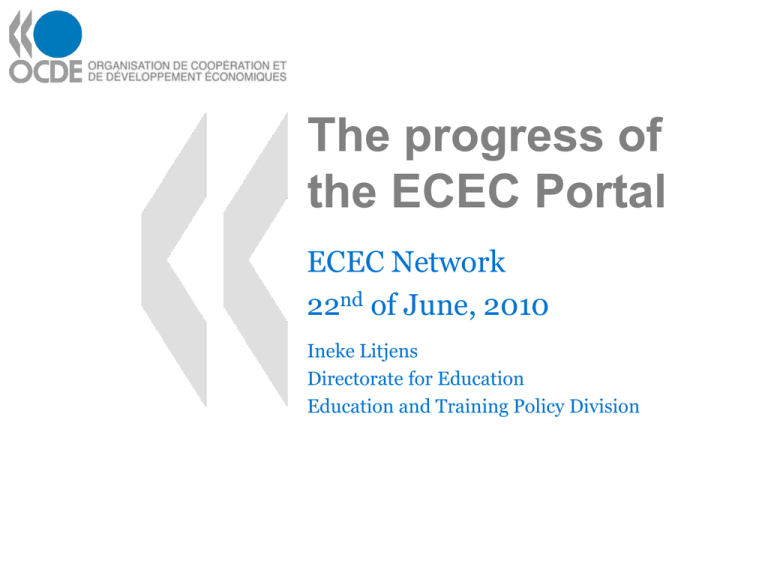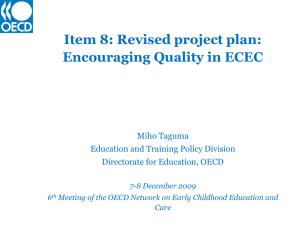The progress of the ECEC Portal ECEC Network 22
advertisement

The progress of the ECEC Portal ECEC Network 22nd of June, 2010 Ineke Litjens Directorate for Education Education and Training Policy Division The ECEC Portal • • • • What is the ECEC Portal? The purpose Plans for the Portal The structure of the Portal: progress to date • Incorporating data and data collection • Outputs • Further steps What is the ECEC Portal? • Not a database: a portal that points to available qualitative and quantitative information/data on ECEC across countries • Includes 8 sections (topics) • Per section: a range of indicators with data for all countries The purpose • Update the SS II country profiles • Pulls in and organizes information from different OECD sources • Includes results from the Network questionnaires • Provide information/data per indicator for all countries at one glance (not: per country individually) One-stop-shop for all OECD data/information on ECEC and young children Plans for the Portal • • • • • One-off project Include explanatory notes Sector specific information Country specific information Based upon the information/data collection, gaps can be identified The Structure Parental and community involvement Data collection, research, monitoring Costs and financing General information ECEC Portal Workforce development and conditions Legislation for access and provision Regulations for quality Curriculum and pedagogy Workforce development and working conditions gfdsg Initial education requirements Training opportunities Work conditions Staff profiles Education level Structure Working hours Female: male Length Length Remuneration % Minority background Provision Provision Staff/child ratio Age Curriculum content Financing Staff turnover rate Accreditation / licensing Curriculum content This information will feed into the Policy Toolbox, which will include policies and strategies Work conditions (2008) Source: ECEC Network Questionnaires Sector Remuneration compared to primary Staff/child ratio school teachers Job title Staff turnover rate Average working hours per week Preschool teacher 8.40% 39.4 87% of average wage of primary school teachers m Child care manager 16% 43.4 70% m Child care worker 21.50% 37.9 55% m 35 56% of average wage of primary school teachers Australia (2006) Early childhood education Day care and Family day care Canada Quebec Early childhood education Pedagogue Day care centre Child care worker/ Educator m 4-5 year: 1:10 5 year and older: 1:20 0-18 months: 1:5 36.6% 32 53% 18 months-4 year: 1:8 Explanatory sheet Indicator Wf 4: work conditions • Definitions and methodology – – – – • • • • Explanation of what is understood with ‘work conditions’ Explanation of definitions staff turnover rate, staff/child ratio a.o. How these have been calculated Why they are included in this indicator Key findings (descriptive and visual) Comparability and data issues Reference to other relevant indicators Further reading Incorporating data • Inputs from the ECEC Network questionnaires and Starting Strong reports – Comparative quantitative data and qualitative descriptions – (policies and strategies to be included in the Policy Tool Box) • Other OECD sources: inputs NOT gathered through the Network questionnaires – Mainly quantitative data: e.g. socio-economic information, labour force data, funding and financing data – From Education database, Family database, Benefits & Wages – Close co-operation with INES, DELSA Data collection ECEC Network/ policy-makers • Quantitative data not collected through other OECD sources: e.g., staff turnover • (Qualitative information regarding policies and strategies to be collected for the policy tool box) • Existing information from SS reports, questionnaires etc. • Missing information collected through Network questionnaires • Updates : one-off activity OECD Resources • Quantitative data with regard to ECEC • General background information and context related information • Updated annually through other departments/divisions • Requires no inputs from the ECEC Network Outputs • Initial use – internal working tool among the network members; with country agreement, online information publicly available • Presentation - for countries per indicator → feed into current work - The project ‘Encouraging quality in ECEC’ / the design of the ‘Implementation toolbox’ • Analyses on ECEC topics (e.g. curriculum or professional development), and outcomes of ECEC • Feed into other OECD databases Further steps • Draft questionnaire • Participation in pilot-run • Questions/concerns?


